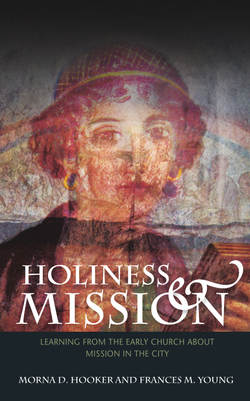Читать книгу Holiness and Mission - Morna D. Hooker - Страница 7
На сайте Литреса книга снята с продажи.
ОглавлениеIntroduction
In his book, on Cities and People, the architectural historian Mark Girouard begins by referring to big cities as romantic places ‘in the sense in which William Morris used the word: “By romantic I mean looking as if something was going on”’. 1 He goes on to write about the way in which the roar and throb of a great city can be exciting or frightening. ‘The rumble seems to become the inhuman sound of a mill which is remorselessly chewing up human beings.’ But getting to know a city dissolves this ‘impersonality’, as one ‘begins to distinguish the endless elements of which it is made up, different societies, different groups, different races, different religions, different family nexuses . . . all of which are constantly overlapping and interacting’. It is access to some of these groups and their interactions which ‘makes human life endurable or enjoyable’, he suggests.
City contexts of that kind were the locations in which Christianity spread, and what holds together the chapters of this book is a search for the kind of thing it has meant to embody the gospel and engage in mission in such places. In the first two chapters, Morna Hooker mines the biblical material for insight into the fundamental call and commission of the apostles, focusing first on the charge to ‘Be holy as I am holy’, what this implied for Israel and how it informed the apostolic mission to follow Jesus in doing the words and works of God. She then explores the adverse image of the city found in much of the biblical material, cities often figuring as places of oppression and injustice, and shows how Jesus and his followers presented a challenge to cities like Jerusalem and Rome. Yet in Acts these cities are identified as strategic centres, and cities facilitated the spread of the gospel. Rome appears as a force for good, as well as being the evil Babylon of the book of Revelation; and the climax of the Bible is in fact a vision of the New Jerusalem. The call is to embody the gospel whatever the cost, and being holy involves not just separation from the world or individual salvation but active presence engaging with the world’s needs and problems. This is to imitate Emmanuel, God with us.
Chapters 3 and 4, by Frances Young, present some findings from historical research into the way Christianity actually spread in about the first five centuries of its existence – in the earliest period, before it had any official status and when it was subject to sporadic persecution and functioned as a somewhat anomalous minority group in the cities of the Roman Empire, and after the conversion of the Emperor Constantine, when the Church found itself patronized by state power and increasingly had to adapt to fulfil the functions in society expected of a religion. Her presentation of the history implies some potential parallels with the Church’s current ambiguous position in post-Christian urban societies, hints at the possibility that when Constantine identified God’s mission with his mission and the attempt was made to Christianize society as a whole some of the most fundamental aspects of the Christian gospel were compromised, and suggests implicitly that we might do better to learn how to embody the gospel in city environments from the Church of the pre-Constantinian period. Within the context of Roman cities, Christian groups looked most like a school presenting a new kind of philosophy, but people seem to have been attracted by belonging to a community, by support offered, both material and spiritual, and by the lived ethic of love, love of neighbour, stranger and even enemy. This would suggest that it is through belonging to open, overlapping networks that people can both discover and begin to embody the gospel in the ‘rumble’ and ‘impersonality’ of the soulless city.
So what about preaching the gospel? The legacy of the eighteenth-century Evangelical movement, together with the missionary expansion of the nineteenth century, means that mission is most often associated with evangelizing and conversion, with bringing people to faith and teaching them the truth. Many would feel that what is needed is a renewed sense of the apostolic commission to proclaim the Good News, especially in the context of the West, where Christianity seems to be on the retreat, routed by the forces of secularization and pluralism. But renewal and reformation often emerge from a return to origins and fundamental principles. In the final chapter, each of the contributors presents some reflections on the implications of the earlier chapters for mission today, briefly considering models and methods of mission, together with issues about truth questions, dogma and doctrine, proselytizing and other faiths. Such themes are taken up also in the Appendix, where contributions from the original audience are given voice. Inevitably only the surface is scratched, but there is common ground in the insistence that it is only by knowing God’s love through hearing the gospel, and experiencing it through participation in loving communities, that people can be empowered to embody that love in lives lived for the sake for others.
Note
1. Mark Girouard, Cities and People, London: Guild Publishing, 1985, p. v.
